This information describes how to use a carbon monoxide testing device to help you quit smoking. It also explains why breath carbon monoxide testing can help you be successful in the Tobacco Treatment Program at Memorial Sloan Kettering (MSK).
You will be taking breath tests using a device called the iCOquit® Smokerlyzer®. It measures the level of carbon monoxide in your breath when you breathe out.
Why it’s important to test for carbon monoxide
A testing device gives you important feedback about your body. We often measure blood pressure, temperature, and oxygen to learn more about what’s happening inside the body.
The iCOquit® device measures carbon monoxide (CO) from cigarettes. It also measures CO from other tobacco products that can burn, such as cigars. This measurement is in parts per million (ppm). Carbon monoxide is a major cause of the shortness of breath and low energy many tobacco users feel.
Carbon monoxide is a toxic gas that blocks some oxygen from getting into your red blood cells. The device can help you get more in tune with your body by tracking carbon monoxide caused by smoking.
Why testing helps you quit if you smoke
The measurement you see after using the device tells you how much carbon monoxide is in your body. That information can motivate you and help you quit. That’s because it measures your progress during tobacco treatment.
You will likely see your carbon monoxide level change over time. Some people say the device makes them feel more responsible and in control. It gives them the power to make changes as they work on quitting for good. Along with counseling, the device helps support and motivate you during treatment.
As carbon monoxide levels drop, you may see other ways quitting helps you. You may be able to breathe more easily and have more energy. Your MSK tobacco treatment expert will talk with you about how your measurements can help you quit smoking.
Download the MSK Remote Monitoring app
The iCOquit® device works with the MSK Remote Monitoring app to take your carbon monoxide measurements. You must download MSK Remote Monitoring app before you start taking measurements.
How to connect the iCOquit® device to the MSK Remote Monitoring app
Follow these steps to connect your iCOquit® device to the MSK Remote Monitoring app..
- Turn on Bluetooth on your mobile device. You can find this in the Settings on your smartphone.
- Enter your MSK MyChart username and password. Log in to MSK Remote Monitoring app (see Figure 1).

- Review the authorization screen and select “Continue” (see Figure 2).
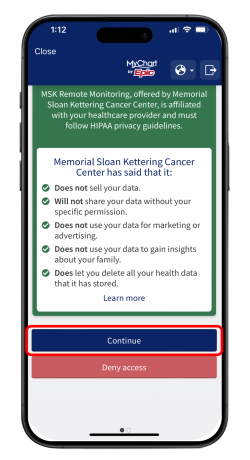
- Review the data authorization screen and select a time range, then tap “Allow access” (see Figure 3).

- You will see the Devices screen. Look for the Carbon Monoxide Monitor tile. Select “Bedfont Scientific” (see Figure 4).

- Tap “Take a reading” (see Figure 5).

How to use the iCOquit device
- Get your iCOquit device. Press the blue power button on the device. Follow the instructions in MSK Remote Monitoring (see Figure 6).

- Wait for the device to connect. In MSK Remote Monitoring, you may get a Bluetooth Permission Request. Select Allow. (see Figure 7).
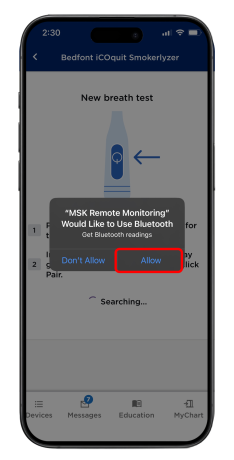
- You’ll see the message You’re connected. Select the “Continue” (see Figure 8).

If you get an error message in MSK Remote Monitoring (see Figure 9), try again. Press the
blue power button on your device.

- Once the device is connected to MSK Remote Monitoring, you’re ready to start your test. Select the “Start breath test” (see Figure 10).

- Take a deep breath (see Figure 11). This is called inhaling.
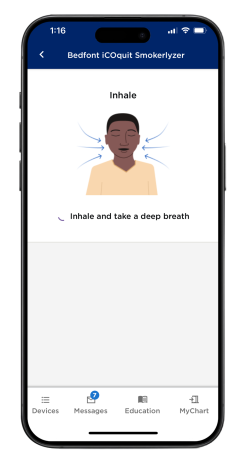
- Hold your breath for about 10 seconds. The screen counts down the seconds (see Figure 12).

- Put the device to your mouth. Do not cover the vent on the back of the device. Slowly blow into the device until you empty your lungs (see Figure 13).
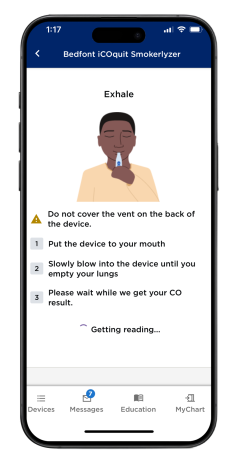
- In a few seconds, MSK Remote Monitoring will show your CO results on your screen. You’re now done with your test. When you see your results, hit the “Submit” button (see Figure 14).
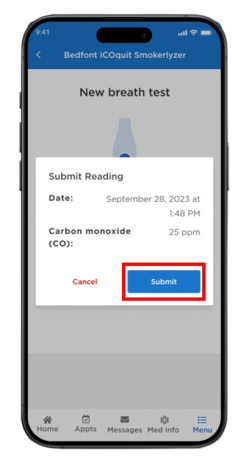
- Your most recent reading will be “Latest” on the screen (see Figure 15). You can see your past readings in a list by tapping the “History” tab (see Figure 16). You can see your reading in a graph by tapping the “Chart tab” (see Figure 17).
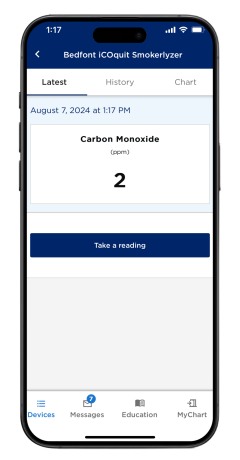

What your breath test results mean
- If the reading is 15 to 30 ppm, it means moderate to heavy smoking.
- If the reading is 7 to 14 ppm, it means light smoking.
- If the reading is 0 to 6 ppm, it means you quit and are no longer smoking.
How to clean the device
To clean the device:
• Wipe the outside with a cloth that’s only a little damp (not dripping wet).
• Do not let water get into the breath or exhaust vents.
• Never put the device in liquid or splash it.
• Never use alcohol or cleaning solutions with alcohol on the device. This can harm the CO sensor inside.